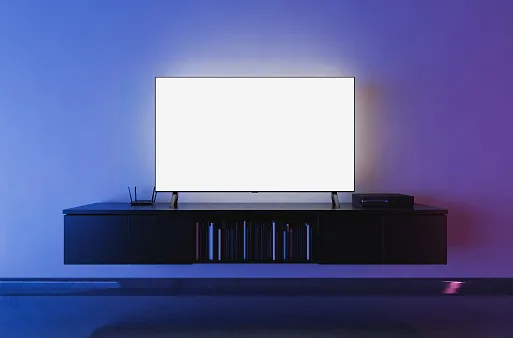Is your Samsung TV giving you the blues… but not the cool kind that makes you tap your toes? Are the colors on your screen making you feel like you’re living on a 1970s acid trip?
Fear not, dear viewer! You’re not alone in your struggle against the pesky Samsung TV color problems that can turn your favorite shows into a technicolor nightmare. But don’t throw in the remote just yet! With a few simple tricks up our sleeve, we’ll help you bring your TV back to life and restore its true colors.
So relax your mind, settle in, and get ready to learn how to conquer those Samsung TV color woes once and for all!
| Color Problem | Description | Solution |
|---|---|---|
| Oversaturated Colors | Bright and unrealistic hues that distract from the action | Adjust the color settings on your TV to reduce saturation |
| Under-saturated Colors | Dull and lifeless colors that remove vibrancy | Adjust the color settings on your TV to increase the saturation |
| Color Banding | Visible lines or stripes in areas where there should be a smooth color transition | Adjust the color depth or color temperature settings on your TV |
| Tint Issues | Green or pink tint that makes characters look sickly | Adjust the color balance settings on your TV |
| Black-level Issues | Dark scenes look gray instead of black, making the TV look washed out | Adjust the brightness and contrast settings on your TV |
By continuing to use this website you agree to our Terms of Use. If you don't agree to our Terms, you are not allowed to continue using this website.
Types of Samsung TV Colour Problems
Get ready to take a journey into the world of Samsung TV color problems! These issues can come in shades and hues, so knowing what you’re dealing with is important. Here’re some of the most common types of Samsung TV color problems you might encounter:
1. Oversaturated Colors
Do your images look like they’re popping off the screen… a little too much? Oversaturated colors can make your TV look like a neon nightmare, with bright and unrealistic hues distracting from the action.
2. Under-saturated Colors
On the flip side, under-saturated colors can make your TV look covered in a dull haze. This can make images look lifeless and lackluster, removing the vibrancy of your viewing experience. Under-saturated colors can make the picture dull and unappealing and detract from the overall viewing experience.

3. Color Banding
Color banding on a Samsung TV can be observed as visible lines or stripes in areas of the screen where there should be a smooth transition of colors. Instead of a gradual blend of hues, the colors appear as distinct blocks, which can make images look pixelated and unnatural.
This issue is especially noticeable in areas of low light or scenes with subtle color gradients, such as a sunset or a sky. Sometimes, color banding can be so severe that it completely ruins the viewing experience and makes it difficult to enjoy the content.
4. Tint Issues
Have you noticed a green or pink tint on your TV? Tint issues can make it look like your characters are sickly or living in a bubblegum world, which is definitely not what you want when you’re trying to watch a serious drama.
5. Black-level Issues
When your TV has black-level issues, you might notice that dark scenes look gray instead of black. This can make your TV look washed out and take away from the overall contrast of your viewing experience.
With these types of Samsung TV color problems in mind, you’ll be ready to tackle any issues that come your way and get back to enjoying your favorite shows in all their colorful glory!
Reasons behind Samsung TV Color Problems
Let’s delve into this perplexing issue and uncover the underlying culprits:
TV being Outdated
TVs are a sight to behold, but like all electronic devices, they have a lifespan. With age, the color processing components in a TV can wear out, leading to color distortion. When the color accuracy and clarity become inconsistent, it’s time to bid farewell to your TV.
Solutions
1. Adjust the Picture Settings
If you’re not ready to upgrade your TV just yet, adjusting the picture settings can help to improve color accuracy and reduce color distortion. Experiment with the different picture settings, such as color temperature, hue, and saturation, until you find a combination that works for you.
2. Use External Devices
If your TV is outdated, it may not have the latest processing power to handle high-quality video. Consider using external devices, such as a streaming media player or a Blu-ray player, to handle the video processing. This can help to reduce color distortion and improve picture quality.
3. Upgrade Your TV
The most straightforward solution is to upgrade your TV. Newer models are designed with advanced technology and offer better picture quality, color accuracy, and processing power. Consider upgrading to a newer Samsung TV model for a better viewing experience.
Placing Magnetic Source Around your TV
Magnetism can be a force to be reckoned with, especially when it comes to electronics. Placing a magnet near the TV can cause color distortion as it disrupts its magnetic field. So, keep your fridge magnets away from your TV, or you might have to say goodbye to your favorite TV shows.
Solutions
1. Move Magnetic Sources Away from Your TV
The first step is to identify any magnetic sources near your TV and move them away. These sources include speakers, motors, and other electronic devices that produce a magnetic field. Keep these devices at a safe distance from your TV to prevent color distortion.
2. Use Shielding Materials
If moving magnetic sources away from your TV isn’t possible, use shielding materials. These materials are designed to block or absorb magnetic fields, preventing them from interfering with your TV. You can use magnetic shields, ferrite beads, or similar products to reduce magnetic interference.
3. Get a Professional Repair
If you’ve tried the above solutions and are still experiencing color distortion, it may be time to get a professional repair. An expert technician can identify the source of the magnetic interference and suggest an appropriate solution. Don’t attempt to repair your TV yourself, as this can be dangerous and may cause further damage.
The Internet Connection Conundrum
The rise of streaming services has transformed the television viewing experience, but a weak internet connection can have a negative impact on picture quality.

When the TV cannot receive data packets efficiently due to poor internet connectivity, it can delay color processing and lead to color distortion. This can be particularly noticeable during fast-paced action scenes or high-resolution content. To avoid this issue, ensuring a strong and stable internet connection is important when streaming content on your TV.
Solutions
1. Check Your Internet Connection
The first step is to check your internet connection. Ensure that your internet speed is fast enough to support streaming services. A slow internet connection can cause buffering, resulting in color distortion. Consider upgrading your internet plan if necessary.
2. Reset Your Modem and Router
If you’re experiencing color distortion despite having a fast internet connection, try resetting your modem and router. This can help to clear any connectivity issues and improve your internet speed, resulting in clearer and more accurate picture quality.
3. Use Ethernet Cable
If you use a wireless connection, try switching to an Ethernet cable. This will provide a more stable connection and minimize the risk of buffering, which can cause color distortion.
4. Disable Other Devices
If multiple devices are connected to the same network, they can use up bandwidth and cause a slower internet connection, resulting in color distortion. Disabling other devices while streaming improves your internet speed and prevents color distortion.
Cable Catastrophes
It’s possible that the cable connecting your TV to the source of content is to blame for color distortion. A damaged or improperly connected cable can result in color shifts or even the loss of color.
Before calling a technician, it’s recommended to check your cables and connections to ensure they are functioning properly. This simple step can help you avoid unnecessary expenses and identify the root cause of the issue.
Solutions
1. Check Cable Connections
The first step is to check the cable connections between your TV and the content source. Ensure that the cables are properly connected and free of damage. A loose or damaged cable can cause color distortion, so checking this before trying other fixes is essential.
2. Replace the Cable
If you’ve checked the connections and still experience color distortion, try replacing the cable. An old or damaged cable can cause signal loss and color distortion. Choose a high-quality cable to ensure stable connectivity and minimize the risk of signal loss.
3. Use a Signal Amplifier
If the cable length is too long, it can cause signal loss, resulting in color distortion. In this case, try using a signal amplifier to boost the signal strength and ensure stable connectivity. This will help minimize the risk of color distortion caused by signal loss.
The Brightness Blues
The issue with setting the brightness too high on a Samsung TV is that it can cause color distortion and washed-out colors. This is because when the brightness is set too high, the color saturation and contrast levels are affected, resulting in less accurate and less pleasing picture quality.
Moreover, a TV that’s too bright can cause eye strain and discomfort, particularly when viewed in a dark room or for extended periods of time. This can lead to headaches, fatigue, and other negative effects on your eyes and overall well-being.
Solutions
1. Use Calibration Tools or Test Patterns
To prevent color distortion, use a calibration tool or test pattern to fine-tune your TV’s brightness and contrast settings. This’ll help you find the optimal balance between brightness and color accuracy, resulting in more pleasing and accurate picture quality.
2. Adjust the Picture Mode
Another solution is to adjust your TV’s picture mode to a “cinema” or “movie” mode, which provides a more natural and accurate color balance. This model is designed to display images with accurate color representation, preventing distortion caused by high brightness settings.
3. View the TV in a Well-Lit Room
Avoid using high brightness settings by viewing your TV in a well-lit room or adjusting the ambient lighting. This will help to reduce the impact of high brightness settings on color accuracy and prevent color distortion.
Moreover, if you’re looking for a black screen fix, scroll below and check out the fix.
FAQS
How do I fix the color on my Samsung TV?
Adjust the picture settings, such as color temperature and saturation, until you find the perfect balance. If that doesn’t work, use a calibration tool to fine-tune your settings. And if all else fails, consider upgrading to a newer model for the ultimate picture-perfect experience.
Why does my Samsung TV picture look bad?
It could be due to incorrect picture settings, a poor quality cable connection, a weak internet connection while streaming content, placing magnetic sources near your TV, or simply an outdated TV model.
To fix the issue, try adjusting your picture settings, checking your cables and an internet connection, avoiding magnetic sources, or upgrading to a newer TV model for better picture quality.
Conclusion
- Samsung TVs can have various color problems that can affect the viewing experience.
- Some of the most common color problems that users may encounter include oversaturated or under-saturated colors, color banding, tint, and black-level issues.
- Various factors, such as outdated technology, magnetic interference, and weak internet connectivity, can cause the above issues.
- Solutions to these problems include adjusting the picture settings, upgrading the TV to a newer model, using external devices, moving magnetic sources away from the TV, using shielding materials, resetting the modem and router, and using an Ethernet cable for a stable connection.
- By implementing these solutions, users can get back to enjoying their favorite shows in all their colorful glory without being distracted by color issues.
Other Articles
- Vizio TV Volume Not Working (No Worries!)
- Installing Netflix On A Samsung Smart TV (Easy Guide)
- Smart Lock For Bedroom Door (Best Options!)
Click here to view the Visual Story Version of this Article.

